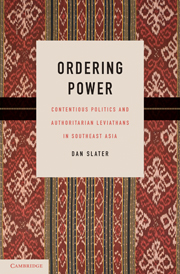Book contents
- Frontmatter
- Contents
- Map, Tables, and Figures
- Acknowledgments
- Map Contemporary Southeast Asia
- Part I The Puzzles and Arguments
- Part II Contentious Politics And The Institutions Of Order
- 3 Colonialism, Cleavages, and the Contours of Contention
- 4 Mobilization and Countermobilization amid Colonial Retreat
- 5 Varieties of Violence in Authoritarian Onset
- Part III The Foundations and Fates of Authoritarian Leviathans
- Part IV Extending the Arguments
- Bibliography
- Index
3 - Colonialism, Cleavages, and the Contours of Contention
Published online by Cambridge University Press: 05 June 2012
- Frontmatter
- Contents
- Map, Tables, and Figures
- Acknowledgments
- Map Contemporary Southeast Asia
- Part I The Puzzles and Arguments
- Part II Contentious Politics And The Institutions Of Order
- 3 Colonialism, Cleavages, and the Contours of Contention
- 4 Mobilization and Countermobilization amid Colonial Retreat
- 5 Varieties of Violence in Authoritarian Onset
- Part III The Foundations and Fates of Authoritarian Leviathans
- Part IV Extending the Arguments
- Bibliography
- Index
Summary
From Why to When: Critical Antecedents in Historical Causation
As detailed in Part I, this book's core proposition can be summarized as follows: Authoritarian Leviathans will only be able to generate the kind of elite collective action that underpins strong state and regime institutions when contentious class politics preceding their onset is perceived by a wide range of upper groups as an endemic and unmanageable threat. How threatening and unmanageable such mass mobilization is perceived to be depends less on its raw intensity than on the specific forms it takes. Contentious class politics will most likely be perceived by multiple types of elites as an endemic threat requiring root-and-branch institutional transformation when it: (1) destabilizes major urban centers; (2) mobilizes radical redistributive demands; and (3) exacerbates communal tensions in the process. When contentious politics takes the form of regional rather than leftist rebellions, elite collective action is more likely to be enhanced within the military alone, permitting the rise of a long-lasting military regime despite a weak supporting coalition.
This may explain why postcolonial Southeast Asia diverged onto separate domination, fragmentation, and militarization pathways; but the question of when this divergence took place requires more explicit analytic attention. At one level, my answer is simple. The period of relatively pluralistic politics between the end of World War II and the inauguration of authoritarian Leviathans serves as the “critical juncture” in my argument. In a cross-case study such as this, critical junctures can fairly be defined as periods in history when variation in a specified causal force pushes multiple cases onto divergent long-term pathways. The causal force at issue in this book is contentious politics, which varied during the postwar critical juncture across Southeast Asia in subtle ways, but with powerful and path-dependent political consequences.
- Type
- Chapter
- Information
- Ordering PowerContentious Politics and Authoritarian Leviathans in Southeast Asia, pp. 55 - 72Publisher: Cambridge University PressPrint publication year: 2010

